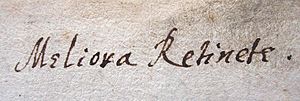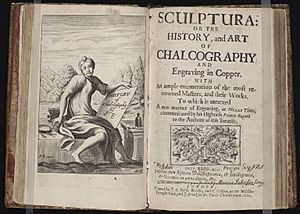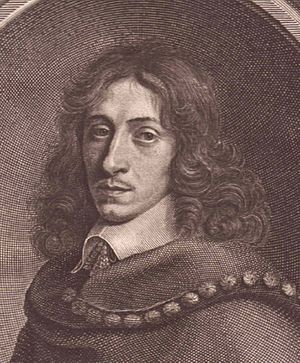John Evelyn facts for kids
Quick facts for kids
John Evelyn
|
|
|---|---|
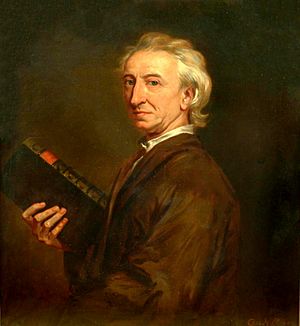
Evelyn in 1687
|
|
| Born | 31 October 1620 Wotton, Surrey, England
|
| Died | 27 February 1706 (aged 85) Dover Street, London, England
|
| Occupation | Writer, gardener, and diarist |
John Evelyn FRS (born 31 October 1620 – died 27 February 1706) was an English writer, gardener, and government official. He is most famous today for his detailed diary. He was also one of the first members of the Royal Society, a group dedicated to science.
John Evelyn's diary covered his adult life from 1640 until he died in 1706. He didn't write in it every single day. These many volumes give us a great look into life and events from a time before newspapers were common. This makes his diary very important for historians today. Evelyn wrote about art, culture, and politics. He described big events like the execution of Charles I, the rise of Oliver Cromwell, the last Great Plague of London, and the Great Fire of London in 1666.
His diary was first published in 1818, after he had passed away. However, it was often less known than the diary of Samuel Pepys. Pepys wrote a different kind of diary, covering a shorter time (1660–1669) but in much more detail.
Evelyn loved gardening more and more as he got older. He wrote a huge book about it, which wasn't printed until 2001. He also translated several French gardening books. His book Sylva, or A Discourse of Forest-Trees (1664) was very important. In it, he asked landowners to plant more trees. He believed England was running out of timber.
Contents
John Evelyn's Early Life and Travels
John Evelyn was born in Wotton, Surrey. His family was wealthy, mainly from making gunpowder. He grew up in Lewes, Sussex, living with his grandparents at Southover Grange. He went to Lewes Old Grammar School but chose not to go to Eton College. Later, he studied at Balliol College, Oxford, and at the Middle Temple in London. In London, he saw important trials and executions.
In 1640, his father died. In 1641, he traveled to Holland. He briefly joined the army but his military experience was short. He returned to England to find the country on the edge of a English Civil War. He joined the Royalist army for a short time. To avoid more fighting, he went abroad.
In 1644, Evelyn visited ancient Roman ruins in France. Then he traveled to Italy. In 1646, he attended anatomy lectures in Padua. He sent some old anatomical preparations, called the Evelyn Tables, back to London. These are believed to be the oldest surviving ones in Europe. He later gave them to the Royal Society.
In Florence, he ordered the John Evelyn Cabinet (1644–46). This was a fancy cabinet made of ebony with beautiful stone and bronze panels. It is now in the Victoria and Albert Museum. This cabinet was likely where his diaries were later found.
In 1647, Evelyn married Mary Browne. She was the daughter of Sir Richard Browne, who was the English ambassador in Paris. For the next few years, Evelyn traveled between France and England. He kept in touch with Sir Richard Browne to support the King. He even met with King Charles I in 1647.
In 1651, Evelyn felt that the King's side had lost hope. He decided to return to England. The next year, he and Mary settled in Deptford (now part of south-east London). Evelyn bought their house, Sayes Court, from his father-in-law in 1653. He soon started to transform its gardens. In 1671, he met a talented wood-worker named Grinling Gibbons. Evelyn introduced Gibbons to Sir Christopher Wren, a famous architect.
Evelyn remained loyal to the King. He refused to work for the government of the Commonwealth. He even used secret codes to write to Charles II. In 1659, he published a book supporting the Royalist cause.
John Evelyn's Public Service
After the King returned to power in 1660 (called the Restoration), Evelyn's career really began. He remained a favorite of the court until he died. He never held a very important political job. However, he did many useful smaller tasks.
In 1660, he helped found the Royal Society. The next year, he wrote Fumifugium. This was the first book about the growing air pollution problem in London. He was also a commissioner for improving London's streets and buildings. He helped with charities and was a commissioner for the Royal Mint.
During the Second Anglo-Dutch War (starting in 1664), Evelyn was one of four commissioners. Their job was to care for sick and wounded sailors and prisoners of war. He stayed at his post during the Great Plague of London in 1665. He found it hard to get enough money for his work. In 1695, he became the treasurer of Greenwich Hospital, London. This hospital was for retired sailors. He laid the first stone of the new building in 1696.
He was well known for his knowledge of trees. His book, Sylva, or A Discourse of Forest-Trees (1664), was written to encourage landowners to plant trees. These trees would provide timber for England's growing navy. New versions of the book came out during his life. The fourth edition, published just after his death in 1706, included an engraving of Evelyn.
Evelyn had some training as an artist and made several etchings. Most of his published drawings were made to illustrate his own books.
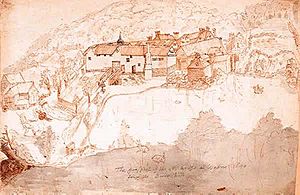
After the Great Fire of London in 1666, Evelyn made plans to rebuild London. Christopher Wren also made plans. However, King Charles II rejected all of them. This was mainly because of how complicated land ownership was in the city. Evelyn was interested in the rebuilding of St Paul's Cathedral by Wren. He also designed beautiful gardens, like those at Euston Hall.
Evelyn wrote many books on different topics. These included religion, coins, politics, horticulture (gardening), architecture, and even vegetarianism. He knew many important people in England and France. In 1671, he visited Sir Thomas Browne in Norwich. Like Browne and Pepys, Evelyn loved books. By the time he died, his library had 3,859 books and 822 pamphlets. It also held his personal writings and letters. This collection is now called the John Evelyn Archives and is in the British Library. Many of his books had his motto: Omnia explorate; meliora retinete ("explore everything; keep the better").
His daughter, Mary Evelyn (1665–1685), is thought to be the author of a book called Mundus Muliebris (1690). This book was a funny guide to French fashion. John Evelyn likely helped edit the book after his daughter passed away.
In 1694, Evelyn moved back to Wotton, Surrey. His older brother, George, had no sons to inherit the family estate. Evelyn inherited Wotton House when his brother died in 1699. Sayes Court was then rented out. A famous tenant was Russian Tsar Peter the Great, who lived there for three months in 1698. He caused a lot of damage to the house and gardens. The house no longer exists, but there is a public park called Sayes Court today.
Evelyn died in 1706 at his house in Dover Street, London. Wotton House and the estate were inherited by his grandson, John.
John Evelyn's Family
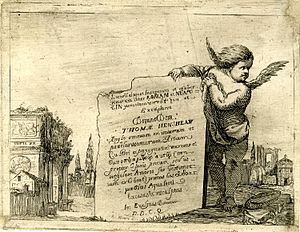
John and Mary Evelyn had eight children:
- Richard (1652–1658)
- John Standsfield (1653–1654)
- John (the younger) (1655–1699)
- George (1657–1658)
- Richard II (1664)
- Mary (1665–1685)
- Elizabeth (1667–1685)
- Susanna (1669–1754). Only Susanna lived longer than her parents.
Mary Evelyn died in 1709, three years after her husband. Both are buried in the Evelyn Chapel at St John's Church in Wotton.
Evelyn's tombstone has an inscription that says he served the public in many ways. It also mentions his "Learned and useful works." It states that he learned "That all is vanity which is not honest and that there's no solid Wisdom but in real piety."
Wotton House and the estate were passed down through Evelyn's family. Many descendants of John Evelyn are still alive today through his daughter Susanna and his granddaughter Elizabeth.
John Evelyn's Writings

Evelyn's diary was not published until 1818. It is a large book with 700 pages, covering the years from 1641 to 1697. It continues in a smaller book almost until his death. Even though entries go back to 1641, Evelyn started writing his diary much later. For earlier events, he used almanacs and other people's notes.
A selection from the diary was first published in 1818. Later editions followed, including modern ones.
Evelyn was a very active writer and produced many other works. While his famous diary has overshadowed them, they are still very interesting. Some of his other works include:
- Of Liberty and Servitude (1649): A translation from French. Evelyn noted he was "like to be call'd in question by the Rebells for this booke."
- The State of France (1652): A pamphlet based on his observations of France.
- An Essay on the First Book of T. Lucretius Carus de Rerum Natura (1656): His translation of a philosophical work.
- The Golden Book of St John Chrysostom, concerning the Education of Children (1658): A translation from Greek.
- The French Gardener (1658): A translation about growing fruit trees and herbs.
- A Character of England (1659): A funny description of English customs, as seen by a foreigner.
- The Late Newes (1660): A response to a critical pamphlet about Charles I.
- Fumifugium: or The Inconvenience of the Aer and Smoak of London Dissipated (1661): He suggested planting sweet-smelling trees in London to clean the air.
- Instructions Concerning Erecting of a Library (1661): A translation about building a library.
- Tyrannus or the Mode (1661): About laws on clothing and spending.
- Sculptura: or the History, and Art of Chalcography and Engraving in Copper... (1662): This book included the first description of "Mezzo Tinto" engraving in English.
- Sylva, or a Discourse of Forest Trees and the Propagation of Timber in His Majesties Dominions (1664): His most famous book, asking landowners to plant more trees.
- A Parallel of the Antient Architecture with the Modern (1664): A translation about architecture, with Evelyn's own notes.
- An Idea of the Perfection of Painting (1668): A translation about painting.
- The History of the three late famous Imposters (1669): About three well-known tricksters.
- Navigation and Commerce (1674): A book about England's control of the seas.
- A Philosophical Discourse of Earth (1676): A book on gardening, later known as Terra.
- Numismata. A Discourse of Medals, Antient and Modern... (1697): About ancient and modern medals.
- Acetaria: A Discourse of Sallets... (1699): The first known book about salads.
Evelyn's friendship with Margaret Blagge, later Mrs. Godolphin, is mentioned in his diary. He wrote a book about her life called Life of Mrs Godolphin (1847).
Many other papers and letters by Evelyn on science and public matters are still kept today. This includes a collection of letters and papers by Sir Richard Browne and Evelyn, now in the British Library.
His book Sylva was the most important during his lifetime, long before his diary was known. Evelyn believed that England was losing its wood quickly due to industries like glass factories. He felt no one was planting new trees to replace them. In Sylva, Evelyn asked for more tree planting. He wrote to the King that he had convinced landowners to plant millions of trees. It was a very useful book about growing trees. It had many pictures of trees and their leaves to help identify them.
He spent much of his later life working on a huge book called Elysium Britannicum. This book was meant to cover all parts of gardening. It was never finished and was finally published in 2001 from his 1,000-page manuscript. Parts of it were published earlier as he realized he might not finish the main work. These included Kalendarium Hortense, a monthly list of gardening tasks, and Pomona about apples.
John Evelyn's Legacy
In 1977 and 1978, a large part of Evelyn's library was sold. The British Library has a big collection of Evelyn's personal papers, including his diary manuscript. The Victoria and Albert Museum has a cabinet that belonged to Evelyn. It is thought that his diaries were kept inside it. In 2005, a new biography about him was published. In 2011, a project began to restore John Evelyn's garden in Deptford.
Many things are named after John Evelyn:
- Evelyn, London: An area in London where John Evelyn lived.
- Evelyn College for Women: A former college at Princeton University, USA.
- A house at Addey and Stanhope School in London.
- Crabtree & Evelyn: A skincare company.
- Evelyn Street: A road in Deptford.
- John Evelyn Primary School: A school in Deptford.
- The John Evelyn public house: A pub in Deptford.
- The Evelyn community garden: A garden in Deptford.
- The Evelyn Street Baths: Public baths that served the Deptford community.
See also
 In Spanish: John Evelyn para niños
In Spanish: John Evelyn para niños





